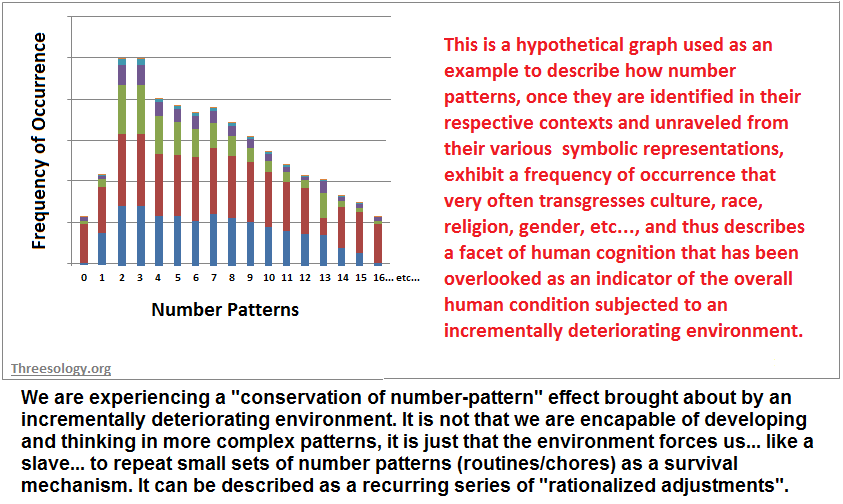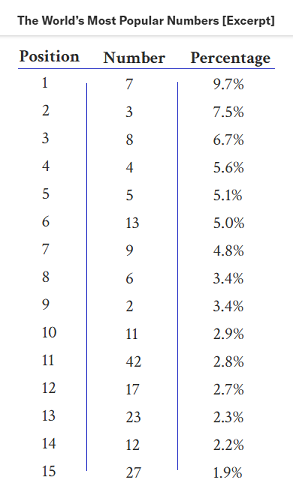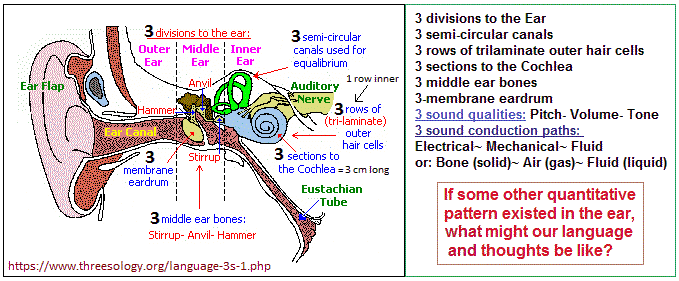| 3s Phenomena Study | Threes Study 1 | Threes Study 2 |
Visitors as of March 17th, 2025
For those unfamiliar with the topic of "Threes", these three links can serve as an introduction to the recurring presence of "threes":
- Michael Eck's Book of threes
- Dr. McNulty's List of threes in Anatomy
- The Beauty of Three Video by Aperture
Numbers are not everywhere... unless you are applying/implying some sense of subitizing (involving different models of memorization) to the human brain. While the apparent standard is to address two types (Perceptual and Conceptual), let me add a 3rd:
- Perceptual subitizing: (intuitive) which is the instant recognition of small quantities (typically up to 5).
- Conceptual subitizing: (contemplative) which involves recognizing and combining smaller groups within a larger set to quickly determine the total.
- Inceptual suitizing: (reflexive) impressed upon/built into the human psyche and can influence behavior unrecognizably at most times. Let us reference cultural, environmental and physiological forms which suggest a process of memorization analogous to "muscle memory".
I say that numbers are not everywhere, because I do not see the number 3 or some pattern-of-three everywhere. Sometimes some other number is more apparent. At other times, it involves a bit of creative thinking or rationalization to conceive/perceive a presumed sense of enumeration even if the final count is zero (nothingness), a singularity, a duality, or some plurality which we may or may not personally favor.
The Study of "threes" involves looking a bit more closely at this recurring phenomena as a sustained cognitive attribute of development and usage in multiple avenues of research such as Physics, Biology/Genetics/ Physiology/Anatomy, Literature, Logic/Philosophy, Mathematics, Literature/Fairy Tales, Numerology, Astrology, Speech writing, Art, Music, Gaming (Games and Gambling), Photography, Artificial Intelligence, Linguistics/Language, Military strategy/logistics, Politics, Criminology, Horse racing, Experimental procedures, Education, Superstition, Religion, Mythology, Computer science/language, etc... Yet, enumeration values do not always show up as a common number symbol. Sometimes number words are used and at other times one must be cognizant of a person or object expressing an enumeration in terms of activity in short, medium or extended periods of times under given singular and/or dual, and/or plural instances.

The study conducted by Alex Bellos concerning popular numbers is referentially supported by his view that ("We're always sensitive to arithmetical patterns, and this influences our behavior even if we're not conscious of it, and irrespective of our ability at maths.") While his online survey discovered that the number 7 was most popular among those who responded to his query, it is not placed into an analysis about the development of counting nor assorted other contextual applicable parameters of discovery as to why, when, where, how, etc... In particular, because no such similar study has ever been taken (at least not to my knowledge), we do not have a means of comparing whether this number had a similar, less than, or more poignant interest in the past, or if it is diminishing over time due to the presumed lessened influence of its advocacy by religions, which the public is apparently moving away from conventional religious ideology.
(The image concerning Army Unit sizes reflects a dominant usage of "3".)
- Since the 1990s, large numbers of Americans have left Christianity to join the growing ranks of U.S. adults who describe their religious identity as (1) atheist, (2) agnostic or (3) "nothing in particular."
- Around the World, Many People Are Leaving Their Childhood Religions
While it is understood that there is evidence for people moving away from religion, we do not have any measurable evidence for them also leaving behind the (numerical or otherwise) superstitions commonly associated with a given religion. Such an idea is most often readily relegated to some supposition that is taken for granted without verification because we assume that a person leaving their religion also leaves behind any and all things which define it.
For example, we do not know whether the once born-into numerical superstitions have been exchanged for enumerations found in one or another science such as physics, chemistry or genetics... or if mathematics is being used as a substitute flavor of an old religious mentality, or if the superstitions being found in multiple types of gaming (gambling), etc..., are extensions of earlier models of thinking patterns which became supplanted into various other interests, some of which have adopted their own respective proofing methods and measurements as a defense against any notion they are simply modernized forms of ancient ideas which retain relabeled and rejacketed ancient ideas.
If numbers and combinations thereof are embedded in the (apparently receptive-to-enumeration) human psyche type of impressionability; what if the changes taking place are due to an unrecognized evolutionary change in human conceptualization which an exploration of the "threes phenomena" has helped to make clearer, even if it turns out that an interest in the "three" has a "tip of the iceberg" relevance when more information is gathered? In other words, researchers of the "threes phenomena" are cognizant of the possibility that it serves as a foot/hand hold to a higher branch of perception, it is not the only branch, tree, or overall vantage point. If not but a road sign marker or crumb seen along a wayward path, it has served a useful purpose.
Is there an interest in numbers overall for all humans, regardless of what that interest may be labeled, if labeled at all? What numbers are being added and which ones are losing favor of usage over time? Is a particular enumeration(s) to be found in an increased or decreased usage of numbers? How about an increase or decrease in the usage of Number-related words? What about Patterns of behavior exhibiting unrecognized enumerations that are not called expressions of an obsession or compulsion? Or is there a decrease even though one might think there is an increase only because of an increasing population using fewer enumerations but is misinterpreted to suggest an increase? In other words, if there are more people using one number yet the usage of multiple numbers by a smaller population has decreased, this could be falsely interpreted to mean an increased number usage.
In other words, we humans have not kept a sustained interest in enumeration over time to see whether there are any changes taking place. We have taken our overall usage of enumeration for granted. Because numbers (enumeration) plays such a large and distinguishing part in human life... and apparently Natural processes... A study of enumeration is important... Psychologically, Sociologically, Philosophically, etc., for us to keep abreast of, just like we do with consensus taking. It does not matter whether you personally think this aspect of human cognitive activity is important or not. Granted, future queries need to be broader and contain more respondents. We also need to differentiate which numbers are true orientations based on some aspect of culture, or are the result of some personalized creation. We also need to know if the number(s) is/are "set in stone" (so to speak), or are arbitrary conventions which change over time due to personal circumstances. For example, is one's interest in a given number cultivated by politics, religion, personal events/attributes, science, mathematics, art, music, etc...?
While numbers can be perceived as existing everywhere, let us not forget it is a tool made-up by humans who have sometimes claimed it as a gift/message from a god. In any respect, let us not become so overwhelmed by the usage of numbers we act like some ancient human who may well have looked to the night sky and became awe-struck as to the presence of such a large quantity and react to it as if someone momentarily looked towards the Sun without closing their eyes... which can produce a "startled breath" sensation that some ancient person no doubt interpreted as having had some communication or audience with a god/king. Indeed, while earlier humans may have expressed a sense of gasping at the sheer quantity, a few humans later on began to isolate the stars into groupings and count them. Upon counting them and stressing some believed-in importance to one and another grouping, we find that the quantity of seven was found. As a point to be touched upon later on in this article, the point to be stressed at this juncture is to acknowledge the presence of a behavior directed towards cognitive grouping coupled to counting, and that the counts were generally of a small quantity... thus stressing a recurrence of a former cognitive limit having been reached when humans began to partake of the journey into developing a counting system, that can be generalized as a "1-2-Many" scenario.
Though humans claim to have access to an infinity of numbers, we find that both humans and Nature tend towards the usage of a conservation of number... of both quantity and quality... which suggests an effort towards optimization by using available resources where a common phrase in the present era is "tweaking the system". This is not to say that one optimization is best overall, but characterizes application of available directions or codes which may be the optimal form of modeling which is actively present during developmental or pre-developmental scenarios. In physics, in biology, in chemistry, in a box of crayons, an artist's palette, the quantity of cylinders in an engine, the quantity of engines used in the space shuttle, building code requirements, troop unit sizing (squads, platoons, companies, battalions...), etc..., we see the use of limitations being imposed (as creations from someone's mind), thus possibly describing that there exists a limitation to our imaginative capability since it too is most likely inclined towards some measure of conservation as a survival mechanism in a planetary system with a course along an incrementally deteriorating line-of-sight for DNA's existence, despite its present adaptability in millions of life forms.
Recurring patterns-of-three for example, can be seen in the common use of:
- Taking 3 X-rays
- Using a 3-drug cocktail for multiple procedures such as the death penalty (in the USA)
- 3 trimesters for pregnancy
- Holding a pen or pencil with three fingers
- 3 grades of gasoline compared to 1 diesel fuel oil
- 3 symbols (minimize- maximize- close) in the upper right corner of a computer
- 3 standard sentence-ending marks (period- question mark- exclamation point)
- 3-day weekend/Holiday observances in the USA
- 3 common time divisions (seconds- minutes- hours)
- 3-month calendar displays: (the previous month, the present month, the following month)
- 3 color business forms were once standard for many transactions
- 3-color (coloritto) Printing Process first described in 1725 by Jacob Christoph Le Blon
- 3 common day divisions (morning- noon- night)
- 3 common work-day divisions (morning shift- day shift- night shift)
- 3 common (US) breakfast meats: Sausage- Bacon- Ham
- 3 common (US) breakfast (alternative) options: French toast- Waffles- Pancakes
- 3 common (US) Combo-meal requests: Hamburger (sandwich)- Drink (soda)- French Fries (main side order)
- 3 common university degrees (Bachelor's- Master's- PhD)
- etc....
While in and of themselves the foregoing examples are commonly taken for granted, it is by collecting them and associating them under the topic of Recurring Cognitive Activity does the idea of a Pattern come to mind; particularly when these patterns-of-three are placed next to other enumerated patterns to highlight differences. By enlarging the list and noting the age when they occurred and whether or not they are in current usage, this assigns to us the task of at least considering that not only is there a change in the cognitive practice of enumerated usage, but that such an occurrence may be due not only to cultural specificities of a given time and place, but that a deeper environmentally influenced biological reason may be at play.
Simply put, if the environment changes and inturn causes biological changes which are symbolically expressed by humans through the activity of the brain by different routes of perception, we might thus be able to detect which environmental changes are at play and make future predictions about basic ideological patterning... particularly if the patterning is directed along a course of a species' extinction. And even though most life forms don't appear to communicate a cognitive aptitude for using ideological constructs, this doesn't mean they are not expressing environmental influences/pressures by way of physiological or behavioral activities.
It only means we humans are not paying close enough attention and actually have no reason to, since there is no established criteria or model for doing so, at least with respect to types of enumeration usage which differ from that commonly used by humans. In other words, the dimensions of communication among different life forms may be as different as human language and thinking adopted and adapted for a given subject. While it is easy to claim there has been a change in the environment/habitat of a species by cataloging population numbers, surely there must have been one or more indicators which gave reference to this upcoming demise... though human interests use the basic dichotomy of living/dead as the major measuring tape.
Here are some ways in which enumeration has been expressed, with some patterns playing a greater ideological role pattern in different eras, including those difficult to decipher in the artifacts of past cultures where number symbolism was appreciably absent:
- Patterns-of-one (singularity, monism, circles...)
- Patterns-of-two (dichotomies/dualities, pairs, binary, binomial, parallel...)
- Patterns-of-four (quadri... four-sided square...)
- Patterns-of-five (quinta..., pentadactyl...pentagon...)
- Patterns-of-6, 7, 8, 9... 13... etc.,
The use of a hypothetical chart can be used as for those whose mind requires visual aids reminiscent of the idea that "seeing is believing". Because some people are visual and creative thinking, they may be inclined to require an image to go along with what they read, and yet that which they visualize may or may not lead them astray of what I am trying to convey in a simple matter:


By placing such patterns together and making a simple count of quantity that will later be understood also in terms of quality, we begin to realize we are dealing with recurring patterns in multiple subjects such as biology and all other activities which can lead us to better understand them as a phenomena which is, for the most part, misunderstood by different subjects:
-
Cultural Anthropologists/Anthropology (science of
humanity) have made varying superficial (albeit distinctive) accounts of enumeration in human life...
- The views appear strikingly synonymous with ancient star gazers having created stories and myths about particular star groupings.
- The Meaning of Numbers Among Different Cultures by Day Translations
- The Number Three in the American Culture by Alan Dundez
- Numbers and their Meanings among Different Cultures by Nisar Nikzad
- The Symbolism of Numbers in Different Cultures: A Global Perspective by Athena Dykman
- The World's Most Popular Numbers by Alex Bellos
-
Psychologists are appreciably ignorant of enumeration in the context of human behavior and development.
- They are caught up in an ancient world of established Dichotomy, and know little of Trichotomization, though multiple ideas by
different creative thinkers (in related fields) have developed three-part ideas:
- Psychologist Sigmund Freud: id- ego- superego
- Neuroscientist Paul MacLean: Triune brain hypothesis
- Psychologist Robert Sternberg: Triangle theory of Love (1986), Triarchic theory of Intelligence (2005)
- etc...
- They are caught up in an ancient world of established Dichotomy, and know little of Trichotomization, though multiple ideas by
different creative thinkers (in related fields) have developed three-part ideas:

-
Mathematicians are vaguely aware of underlying recurrences with the advent of set theory ideas.
- Mathematicians persist in retaining romanticized notions of Mathematics such as The Unreasonable Effectiveness of Mathematics in the Natural Sciences (by Eugene Wigner)
- Another romanticized notion created by motion picture script writers is that numbers are fundamental and that all intelligent (alien) species will necessarily understand communication efforts based on human-designed mathematics... because humans believe their brand of mathematics is pure and universal.
- (Because of its top-heavy reliance on a foundation of dichotomies, I need to write a paper entitled "The Reasonable Ineffectiveness of Mathematics in the Natural Sciences", or it wouldn't attempt to create different models of Trichotomy.)
- The underlying presence and usage of dualities in mathematics needs to be viewed as an expressed time-line feature of cognitive development where the dualities of yin/yang, Binomial Nomenclature in Biology, dualities in Psychology, and the Binary code of computers are sorted alongside trichotomization which, in Biology and basic counting development, reveals a 1-2-3 (set) of development.
-
Pseudo-sciences such as Numerology and Astrology have extremely narrowed focusing about enumeration.
- Listing examples of different enumerations without following up with a more comprehensive philosophy involving origination and
possible predictabilities leaves such ideologies in the realm of relying solely on rationalized supposition and make-believe... despite
having 3 levels of believers:
- Day -to- day (fully immersed) users
- Occasionally frequent (non-preoccupied with) users
- Infrequent/Intermittent users
- Listing examples of different enumerations without following up with a more comprehensive philosophy involving origination and
possible predictabilities leaves such ideologies in the realm of relying solely on rationalized supposition and make-believe... despite
having 3 levels of believers:
-
Writers in most genres are aware of enumeration for specialized applications typically involving some "rule of three".
- Such "rules-of-three" typically originate as a copy-cat scenario.
-
Military strategists/Logicians are not taught about cognitive enumeration values and use personal experiences thereof.
- Military academies typically teach a reliance on "predecessor role modeling" which are pre-established values to be incorporated into personal experiences to create an Egotistically framed chain of command embodied in sleeved patches and other emblems... instead of assisting students to embrace an understanding of cognitive enumerations from which an enlarged calculus of strategy and logistics can be formulated by noting limitation(s) and how to surmount them when needed in different terrains when no former history provides illumination of what to do in given circumstances; where personal creativity and originality of thought are the only rule-of-thumb by which decision making can best be applied to orders that may need to be modified as a requirement of flexibility that senior officers and enlisted memberships can appreciate and defer to if they have had training in cognitive enumeration studies beyond that discovered on the battlefield, changed duty stations, and changed occupations.
- Artists continue to use their crafts as mediums for projecting impressions of cognitive enumeration events.
- Look at any artwork and you can see expressions of enumeration... that is if you are sensitively aware of such patterning and its multiple formulations. Some artists are keenly aware of their usage of enumeration, others less so, and others think to exceed such symbology and referencing for varying reasons... or excuses.
-
Musicians use their efforts to compile creative redundancies of enumeration frequently resulting in "hooks" as exercised
repetitions.
-
While use of enumerations in music is widespread, not so is the understanding of human inclinations towards certain patterns and usage.
Such an understanding may well lead to an enlightened and purer compositions of impression and expression which music geniuses are
tapped into and use intuitively, but are not necessarily consciously aware of.
-
Theologians/religion remain(s) superstitious/metaphysical about the "three" and other usage of enumerations...
- There are multiple uses of number, but an exploration into the development of greater insight is nullified by a reliance on antiquated notions of enumeration defined as sacred and thus inviolable from realistic and non-rationalized investigation.
-
Eastern Philosophers/Philosophies practice adolescent orientations towards the "three" (and other enumerations as well
as geometric patterns laughable displayed in various cultural venues, many of which are commercialized in way disrespectful to
declarations of sacredness).
- Buddhism, Hinduism, Jainism, etc., all have specialized "three" (and other number) uses which are treated in much the
same manner as other religions do their orientations of enumeration.
- Buddhism Numbers
- Hinduism Numbers
- Number Three commonality in multiple religions
- A Witch's Guide to the Power of three (Present day White magic associated with the Wicca community, and frequently begins to overlap with Numerology, Astrology, Spiritualism, "incantation-ology", crystalology, etc...)
- Numerology is the belief that numbers hold a spiritual and mystical significance
- Spirituality, Astrology, Divination, and Numerology go hand in hand; with different religions using one or more with differing levels of importance. (Example reference: Origin of Astrology in Religious Beliefs)
- The Number 3 In Islam
- Judaism and the Number 3 by Rabbi Dr. Hillel ben David (Greg Killian)
- The Triple deity and the number three in Pagan Mythology, by Nigel Borrington
- Buddhism, Hinduism, Jainism, etc., all have specialized "three" (and other number) uses which are treated in much the
same manner as other religions do their orientations of enumeration.
- Most normal/common/everyday people remain oblivious to the topic of cognitive enumerations though varieties appear with everyone (such as in simple 1-2-3 or A-B-C or person-place-thing or subject-object-verb counting, accounting methodology, filing, categorical ordering, shopping lists, time allocations, etc...).
And let me emphasize that yes, those of us interested in the topic of "threes" are familiar with other number and non-number patterns. However, let me be clear, I am interested in and prefer the Study of the Threes Phenomena which of late I have been referring to as "Trichotomization". While listing various examples of the "three" reference from different subjects is useful in that it provides evidence for its ubiquity (a word being used to describe its presence in multiple places), I am fully aware that it and its geometric models are absent from other circumstances.
For example, the common theme among Astronomers today is to speak in terms of "binary" planets. The word "binary" is used more often than singularity, trinary/ternary, quadruple, quintuple, etc... If the "three" had a significant cosmological importance, one might want to consider its absence from how the stars are arranged, unless we humans are too stupid to understand the larger picture, or/and the larger picture continues to unfold and/or the present moment in history is too early to provide an accurate picture of an unfolding "threes" theme... and/or we don't actually understand what a recurring "threes" them actually means... and not as some superstition, obsessive/compulsion, misidentification, misunderstanding, etc...
In other words the "three" (in whatever shape or form) is not being viewed by me as a god or some intellectually-grasped great cosmological truth and nor do I study the "threes phenomena" as a sanctified religious icon such as repeating a 3-lettered (A-U-M: OM) mantra. Granted, as I have gathered information over several decades, I have had to adjust my thinking in accord with the evidence being uncovered... and it has nothing whatsoever to do with some religion or Eastern Philosophy... Despite those that have cast the dichtomy/trichotomy idea into the superficiality of religion: Dichotomy vs. Trichotomy: Biblical and Theological Perspectives

Om, in Hinduism and other religions chiefly of India, a sacred syllable that is considered to be the greatest of all the mantras, or sacred formulas. The symbol Om is composed of the three sounds a-u-m (in Sanskrit, the vowels a and u coalesce to become o), which represent several important triads: the three worlds of earth, atmosphere, and heaven; the three major Hindu gods, Brahma, Vishnu, and Siva; and the three sacred Vedic scriptures, Rg, Yajur, and Soma. Thus Om mystically embodies the essence of the entire universe. It is uttered at the beginning and end of Hindu prayers, chants, and meditations and is freely used in Buddhist and Jaina ritual also. From the 6th century, the written symbol designating the sound is used to mark the beginning of a text in a manuscript or an inscription. The syllable is discussed in a number of the Upanishads, which are the texts of philosophical speculation, and it forms the entire subject matter of one, the Mandukya. It is used in the practice of Yoga and is related to techniques of auditory meditation. In the Puranas the syllable is put to sectarian use; thus the Saiva mark the lingam, or sign of Siva, with the symbol for Om, whereas the Vaishnava identify the three sounds as referring to a trinity composed of Vishnu, his wife Sri, and the worshipper.
Britannica: OM
Interestingly, the topic of "auditory meditation" does not typically direct people to look at the construction of the human Ear, nor make any effort to look at language and linguistics, not to mention speech making or story creation in which the "3" theme plays a dramatic role. In other words, the recurring "threes" in the ear would seem to suggest that we can experimentally create a means to test the hypothesis that if the human ear was other-than-three patterned, human speech and cognition might well be different.

To me, the recurring "threes" in our biology, anatomy and ideology suggests an ongoing environmental influence related to the Sun, Earth and Moon. Hence, as the environmental conditions which have prevailed for the development of our biology continue to change, we might also be able to detect changes initially in our ideologies, since they seem to be most vulnerable to external and internal influence. In other words, there are three distinct environmental events which have the potential for change and influence:
- The Sun is said to enlarge as it burns out, thus "fusing" or melding the three innermost planets into a singularity (hence, a 3 into 1 ratio like the Christian idea of 3 persons in 1 godhead... which suggests the idea of the Trinity originates with ancient (pagan) solar orientations adopted by multiple mainstream religions... most of which did not necessarily worship the Sun, and instead practiced an active orientation towards it by devising multiple types of nature/fertility practies.)
- The Moon is receding, thus effecting a slow down in the "washing machine effect" that tides supply.
- The Earth's rotation is slowing, which means it was faster in the past and created the condition in which the Sun's 3 phases/moments (dawn- noon- dusk) were illuminating early photosensitive building blocks of life with a 3-patterned strobe-light effect undergoing a "fusion" as the Sun enlarges and the Earth slows.
Page posted: 10:20 AM, Saturday, March 15th, 2025.
Updated posting: Monday, May 19th, 2025... 7:31 AM